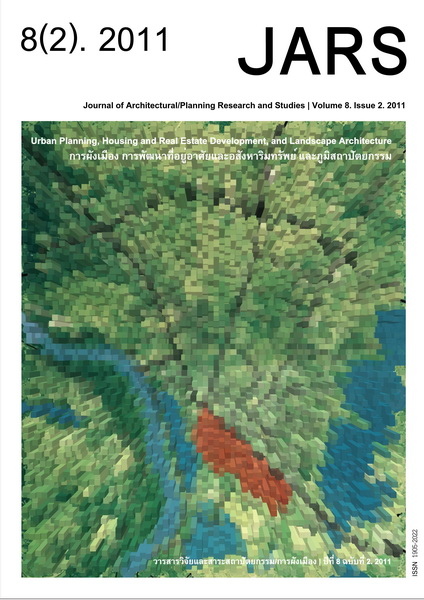Community Risk Assessment: Spatial Patterns and GIS-Based Model for Fire Risk Assessment - A Case Study of Chiang Mai Municipality
Main Article Content
Abstract
The main purpose of this study is to develop a GIS-based approach to fire risk assessment to identify
sites for disaster mitigation planning and management. Fire risk assessment has two main factors: the vulnerability
and capacity for mitigation of the areas, as well as the areas with a fire history. The selection of risk
factors is mainly based on stakeholder analysis, involving four groups: urban planners, fire wardens, local residents
and local government officials. The above data are integrated into raster-based GIS software and then
spatial analysis is performed using an overlay technique to generate the fire risk, ranging from high to low according
to its sensitivity to fire or fire-inducing capability. The result is a map of the varying levels of fire risk
across the city. The weight to each factor is determined by an Analytical Hierarchy Process (AHP). This model
is illustrated with a case study of fire risk of area in the Chiang Mai Municipality (CMM). It is suggested that
risk mapping is helpful for fire management to minimize fire hazards.
Downloads
Article Details

This work is licensed under a Creative Commons Attribution-NonCommercial-NoDerivatives 4.0 International License.
All material is licensed under the terms of the Creative Commons Attribution 4.0 International (CC-BY-NC-ND 4.0) License, unless otherwise stated. As such, authors are free to share, copy, and redistribute the material in any medium or format. The authors must give appropriate credit, provide a link to the license, and indicate if changes were made. The authors may do so in any reasonable manner, but not in any way that suggests the licensor endorses you or your use. The authors may not use the material for commercial purposes. If the authors remix, transform, or build upon the material, they may not distribute the modified material, unless permission is obtained from JARS. Final, accepted versions of the paper may be posted on third party repositories, provided appropriate acknowledgement to the original source is clearly noted.
References
Chainey, S., & Ratcliffe, J. (2005). GIS and crime mapping. West Sussex, England: John Wiley & Sons.
Jiamchaisri, A. (2006). ขนาดและขอบเขตพื้นที่รับผิดชอบที่เหมาะสมของสถานีตารวจนครบาล [Optimum responsible areas and boundaries for Bangkok metropolitan police station]. Master Thesis, Faculty of Architecture, Chulalongkorn University, Bangkok, Thailand.
Nimmanahaeminda, U. (1967). ปัญหาทางการผังเมืองทางด้านอัคคีภัยในประเทศไทย [The urban planning for fire management in Thailand]. The conferences proceeding of urban planning and architecture studies. Bangkok, Thailand: Pranakhorn Publisher.
O’Sullivan, D., & Unwin, D. J. (2003). Geographic Information Analysis. USA: John Wiley & Sons.
Saaty, T. L. (1977). A scaling method for priorities in hierarchical structures. Journal of Mathematical Psychology, 15(3), 234-281.
Saaty, T. L. (1980). The analytic hierarchy process. New York: McGraw-Hill.
Suwan, M. (1998). ระเบียบวิธีการวิจัยทางภูมิศาสตร์ [The quantitative techniques for geography]. Bangkok, Thailand: Odeon Store.


